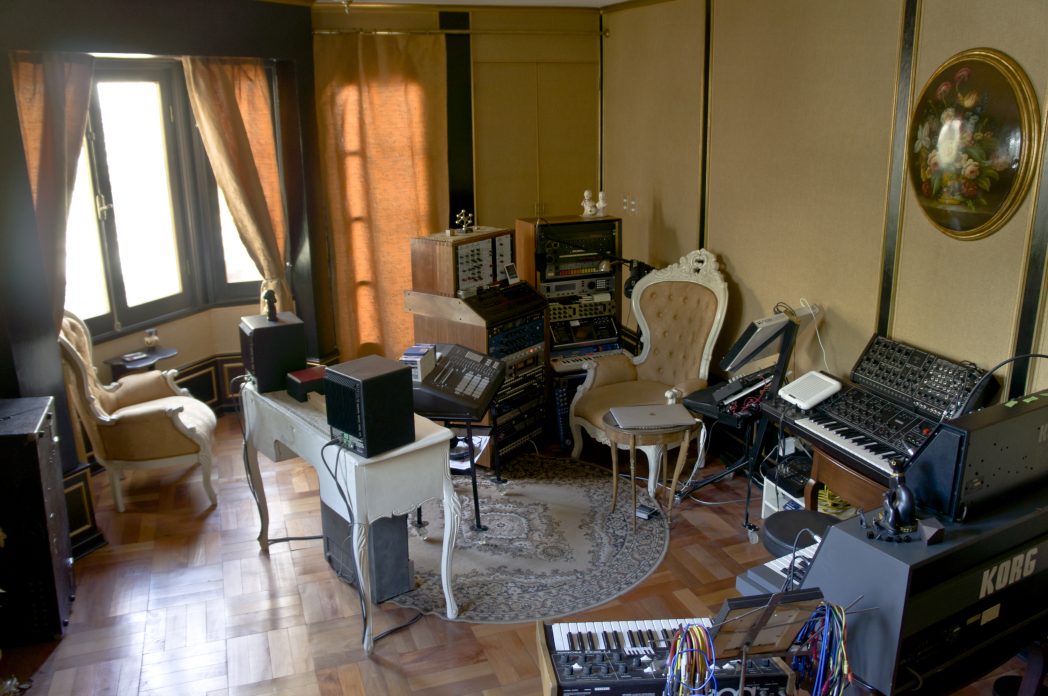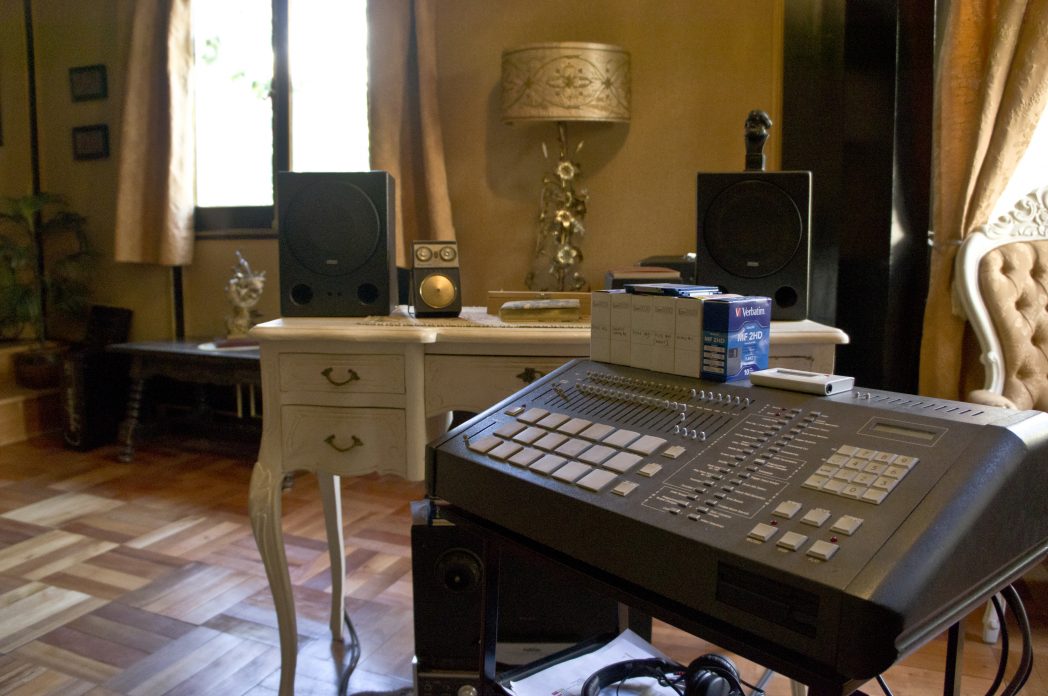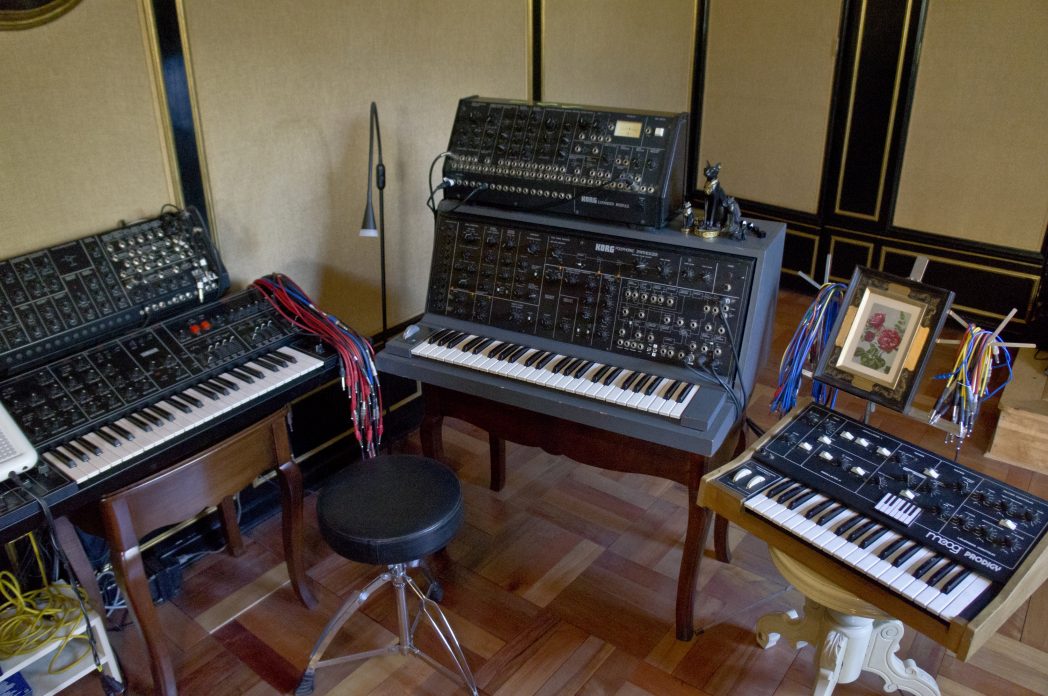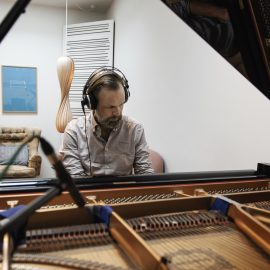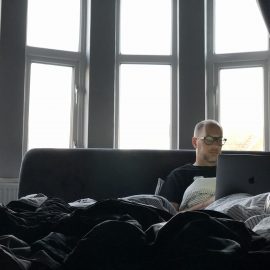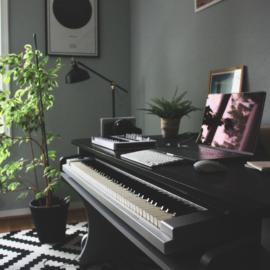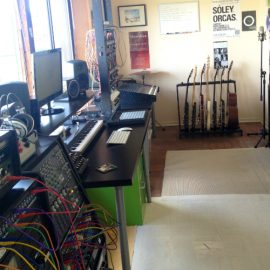“… too much gear usually leads to boring ideas, while many good ideas reduce the amount of equipment…”
Let’s start at the very beginning. Can you tell us how you got involved in composing, and what was your very first piece of gear?
I started making music when I was around 14, playing the drums. I then switched to a drum machine, after I had heard a drum machine on the radio. I would say that with my first drum machine, the composing began, albeit in a very simple manner, of course. My first piece of gear was a Korg DDM 110, a tiny, very simple digital drum computer. I can remember that I programmed stuff on it all day long, for many, many months, until, I think, I had tried everything possible with this piece of equipment. I think I owned this machine for maybe two years until I got in touch with other people with which I wanted to make music and decided that I needed a better machine. I then switched to the Yamaha RX5, which I used not only as a drum machine but actually as a MIDI sequencer as well, triggering my first synthesiser, a Moog Prodigy. I owned this second drum machine for many, many years and programmed all my recordings on it until around 1992 or so.
How many different studio iterations have you gone through, and what does your final setup look like right now?
Counting only the elementary changes and changes of location, my studio had four iterations. There was my first studio, back in Frankfurt, which, even though it went through very big changes, due to the fact that I had just started to make music, and therefore the equipment kept changing, was basically the same in terms of a basic setup. Then I moved to Chile in 1997 and had very much the same setup but in a new location. I kept this setup until around 2003 when I decided to get rid of every single piece of gear I had because I really wanted to focus on working within Protools only. I would consider this phase my third iteration. For about ten years then I made all my records on a 12″ Powerbook. My studio consisted only of the computer running Protools 6.4 and a Meyer Sound near field monitoring, which I still use today. I then changed to my current studio in 2009, which I call the “Bowman Suite”. The configuration you can see on the pictures represents more or less the initial idea of the studio, even though over the years some pieces of gears came while others went. The core, however, remains the same.
I would consider my work very much Protools based. I’m not into MIDI, nor into jamming or recording songs running multiple pieces of equipment linked/synced together. This is why no sequencer or drum machine is actually synchronised to any other machine or the computer. My method rather consists of constructing tracks within Protools, layering and overdubbing… replacing, refining, editing, and so on. I very often play instruments manually or program very simple things, either within Protools or on external machines. No matter how the material is generated, it then all ends up in a Protools session where it is being edited and put into place. If necessary it will be rerecorded, rather than trying to maintain sequencing/MIDI setup.
The selection of instruments then is also a rather strange one, in the sense as that I tend to use every single machine for distinct purposes, yet never everything at the same time, nor necessarily in the same composition. Some machines I do not turn on for years sometimes, depending on the project I may be involved with at that time. To the biggest degree, I don’t even consider most of the machines I have that necessary, especially the synths. I have always preferred really minimal setups, which force me to get my ideas done with the smallest amount of machines possible. For the same reason, I do consider other pieces of equipment much more important, such as the Neve modules or any other compressor/eq I own. I prefer to tweak, let’s say a Linn 9000 source material into all kinds of different types of sounds than actually owning heaps of different drum machines.
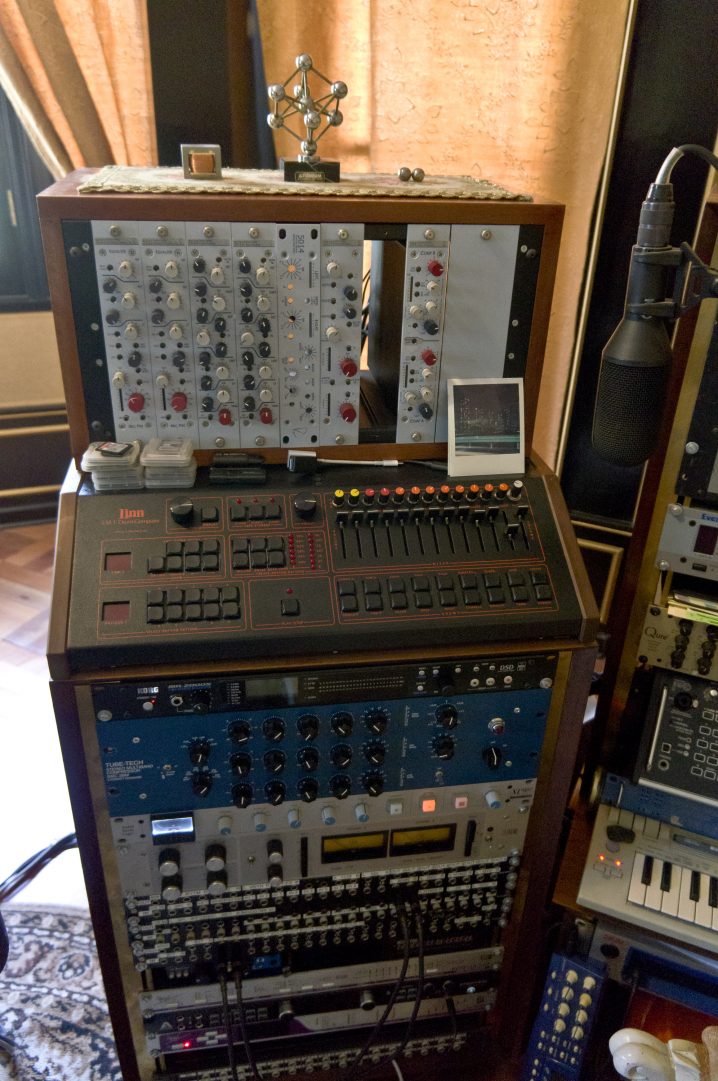
The same is true for my synth selection, which is a rather peculiar one, in the sense that some of the machines arrived at my studio without any previous plan in purchasing them. Some of the synths I had given to me, others I just found without knowing much about them, and over the years I began to either enjoy them or gave them away. The only exception, of course, is the Moog Prodigy, which is my very first synth and therefore the reason I still own and sometimes use it. Usually composing or recording a piece of music starts with an idea, not with a piece of equipment. I then try to find out with which machine, or combinations of machines I can achieve that idea. Also, the actual use for every machine may take different shapes, in the sense as that a synth can as well end up being used as a drum machine or a drum machine being used as a synth.
Tell us about your favourite piece of hardware.
Not an easy answer! Looking at it from an emotional, historical but also result-oriented perspective, I would say it is the Linn 9000. Now, at the same time, the Linn 9000 is the worst piece of equipment I own in terms of reliability! 80% of the cases I turn it on it presents some kind of bug or malfunction, and I have to open it up frequently, clean it, take out the cards, etc. Now, all that being said, once it works, it is the most fun and satisfying piece of gear to work with. It plays a very important role in sound design for me, and I use it for all sorts of tasks. I hardly ever program large patterns on it, but use it very much for creating drum or synth sounds which I then rework in other machines. It produces great raw material in a sense like that, albeit being 8bit and 21 kHz only, it beats any contemporary drum machine in terms of sound. I also admire it a lot in terms of design and overall vision. I think it was very ambitious and daring of Linn to have built it. It was the reason why Linn went bankrupt after all, mainly because the machine never really worked in a reliable fashion. That very fact though makes it an almost “personal” piece of equipment, in the sense that it feels kind of “homemade”, as compared to nowadays much more professional machines. When you open it up, something I have to do quite a lot, one can see how improvised much of the hardware is, with ICs and wirings made fit long time after the initial design had been finished. However, the overall layout and functionality are still very intuitive and genius. I would actually place the Linn 9000 right next to the LM-1, talking about my favourite, yet the 9000 would take the first place, only because the LM-1 is much less versatile as a sound source.
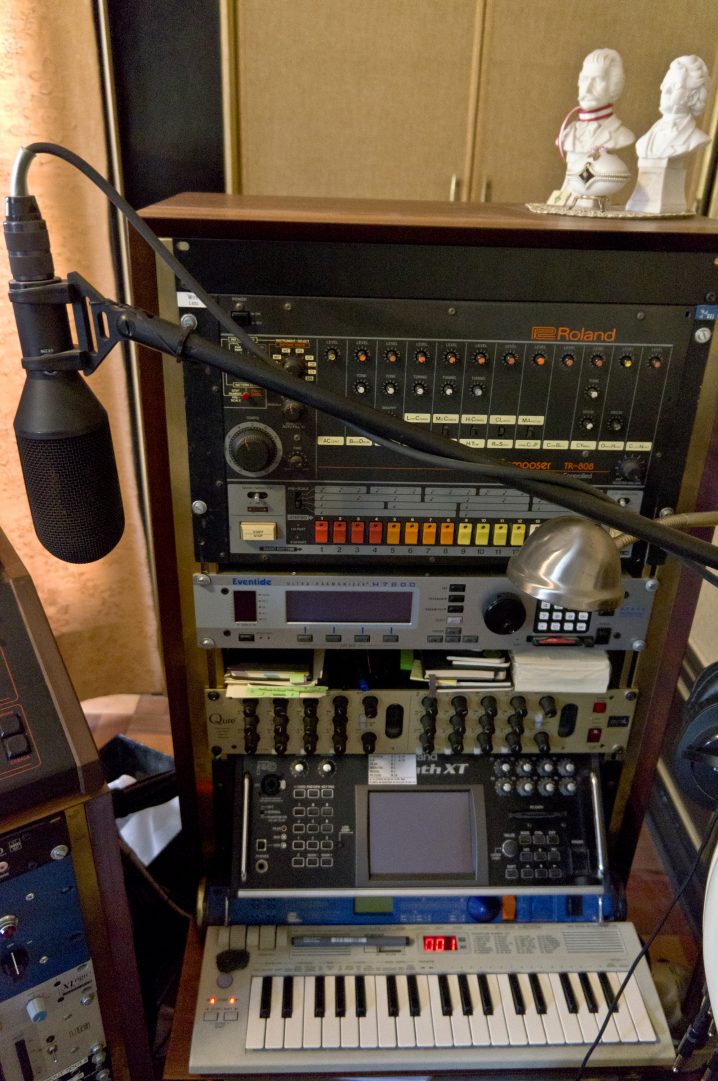
And what about the software that you use for production?
It’s mainly Protools with very, very little use of plugins. As I mentioned above, I got really into that software a long time ago when I had decided that I wanted to master it and make it my main compositional tool. Once I have a Protools system running, I usually don’t touch it for about 8-10 years. My studio computer is offline; I don’t update anything, once I feel that it runs smoothly and does everything I need it to do. Changes in soft- or hardware usually cause changes in my workflow. The efficiency, speed but more so, the general quality of my work can suffer quite a bit from being confronted with changing GUIs or how machines behave. Upgrading a system has on some occasions caused me big troubles and I am very careful with doing so. I tend to carefully analyse the need for an update and then often rather change the entire system, than just a minor component. This means not only upgrading the software but often the computer and the interface as well. For obvious reasons, I don’t want to do this too frequently. I don’t consider myself a “gear guy”, but rather prefer developing ideas and executing them. Changing, or even buying new equipment I find completely unexciting and rather a problem than something I would enjoy. I’m happy with super reduced setups I can use for a long time since I feel that I am getting better at using it. Also, there is a moment where a piece of equipment, once you get to know it very well, starts to become an element of the ideas you develop. I can then mentally layout an idea and its execution even before having to touch a piece of equipment physically, which is a great advantage.
Is there a particular piece of gear that you’re just dying to get your hands on and do you think one day you’ll have it?
Quite frankly, there isn’t. I mean, there are many, many machines I theoretically “would like to own”… but this is a very theoretical thing to say because at the same time I rather prefer not to have too many machines sitting around in my studio. Now, I think that every machine ever made is a universe in itself which may be valid being explored. To me, this entirely depends on how those machines relate to a set of ideas or approaches I’m interested in. Let’s say, I would love to own a Jupiter 8, for example, which is one of my favourite synths. But then, I don’t like huge keyboards and really don’t want to put a piece of equipment like that in my studio… simply for the sake of reduction and focus. The list of “interesting” machines is very long and using every single one of them I find worthwhile. It doesn’t mean that I crave them. I’m not a collector. Studios full of gear usually rather bore me, and I find them unattractive. There seems to exist a universal equation, which on one side states the amount of equipment and on the other side the amount of ideas. Too much gear usually leads to boring ideas, while many good ideas reduce the amount of equipment.
Can you please share some aspects of sound design in your work?
Probably the most important element of sound design to me has to do with the possibility of being “close to the sound”. In that sense, Protools is the most perfect environment to do so. Almost everything I do is related to timing, either in the sense of transients or frequencies. Over the years, I have developed a method of building sounds which appear to be “simple”, yet contain out of sometimes very complex arrangements of layers. In order to do that properly, the reproducing software has to be absolutely perfect in order to avoid phase- or other time-related problems. I had very disappointing experiences with other DAWs in the past, yet feel very safe in my current software surrounding. Those layered sounds I then often reduce down to single sounds again, and they are being swapped between the DAW and various other instruments. It’s something like “zipping” different sounds into one, often done multiple times. To maintain the integrity of the sound throughout the process, I find essential here. The second key element to me is the easiness with which I like to get to a certain result in my studio. Very often, complex studios are very difficult to navigate, and one loses a lot of time just patching and preparing the eventual signal path, for example. I have always preferred studios which may be less complex and even less complete, but with enough freedom just to repatch things or to very quickly printing an idea, even when played manually and corrected afterwards. I enjoy audio editing a lot, so, moving snippets of audio around is often what it comes down to anyways. In general, I do not distinguish sound design very much from the other aspects of composition, as everything is usually tied to sound design to some degree.
Any particular new techniques that you tried out for your new album?
For the production of “<3” I had specifically purchased the Eventide H7600 and for most of the sound design I used this machine. The same goes for the combination of the Akai Z8 sampler, the Korg hard disc recorder and the Protools system. The main technique had to do with a very specific sound I had in mind, and which did not have any correspondence with any known piece of gear (hard- or software), hence, I had to invent that “sound” by myself. The above-mentioned chain of machines has to do with being able to transfer and treat sounds amongst them, sometimes just within the digital domain, sometimes using the analogue outboard gear. The idea was to achieve a low-loss signal chain, so I could treat certain elements over and over, shaping them in specific ways until they become what I had in mind initially. All this had to do with a rather “high end” type of sound. That being said, I wanted to come up with a method to shape sounds which I had not known before and which, as far as I know, have not been heard before. Very often I would send sounds in between all those machines, even the LINN 9000, albeit its 8 bit sound, achieving more depth and complexity of a sound. The entire process had a lot to do with researching and finding out the actual method and technique which would bring me to said sound. I started doing this from ground zero and just had a glimpse of an idea which direction to go in terms of equipment needed for doing so. As I said, I learned a lot by doing so, and the investigation has by no means come to an end. I rather feel, it just has started, as I hope to include those results in upcoming works and iterations of my studio.
What does your live setup look like, and what do you bring with you when you travel for an extensive tour?
My live setup has nothing to do with the studio setup. I consider both spheres very distinct from each other. My live setup depends on the kind of live set I am performing. In some cases I use only a computer, in others, when it’s about more improvised music, I use MPC 1000, xox box iosynth, H9 effect unit, laptop, jomox kick drum module, acme 4 master clock and some outboard to be provided by the venue. All of that has to fit in a hand luggage trolley.
What is the most important environmental aspect of your current workspace and what would be a particular element that you would improve on?
As a matter of fact, the studio you see here, the Bowman Suite, will be closed sometime very soon. I have decided that after ten years of using this studio, I would like to go into the next iteration. There are many things I have learned in this studio over the last decade, and I would really like to explore an expanded approach of the current setup. This will probably mean a reduction in gear in some aspects and changing other parts of the studio in an upgrade fashion. What that EXACTLY means I am exploring right now, so I can’t tell just yet. Over the last years, I’ve been increasingly interested in “high res” recording and improving the signal path quality. I think this will be a major focus in the upcoming change.
As for the environmental aspect, as you can see, I’m not really into how studios usually look. Since my work is mainly computer-based, the focus lays on a comfortable environment, a place where I can concentrate and want to spend many hours. It’s more something like a living room with equipment in it.
What can you tell us about your overall process of composition? How are the ideas born, where do they mature, and when do they finally see the light?
The composition is often a very long and twisted road. Sometimes it is quick and instantaneous. It really depends on which set of ideas I am carrying around. Talking about “<3”, I did all the compositions during 2019, even though I had demos or drafts of some of the tracks which date 3-5 years back. However, this time, I wanted to spend more time and headspace in creating a homogenous sound for the entire album, something, I think, I failed to do on “HD”. For that very reason, I had collected all the ideas, drafts, lyrics, etc. and held them back until a more focussed period, in which I recorded all of it, applying the above-mentioned sound design technique. I was really into an overall texture and sound for the entire album, which required a much more elaborated workflow and technique.
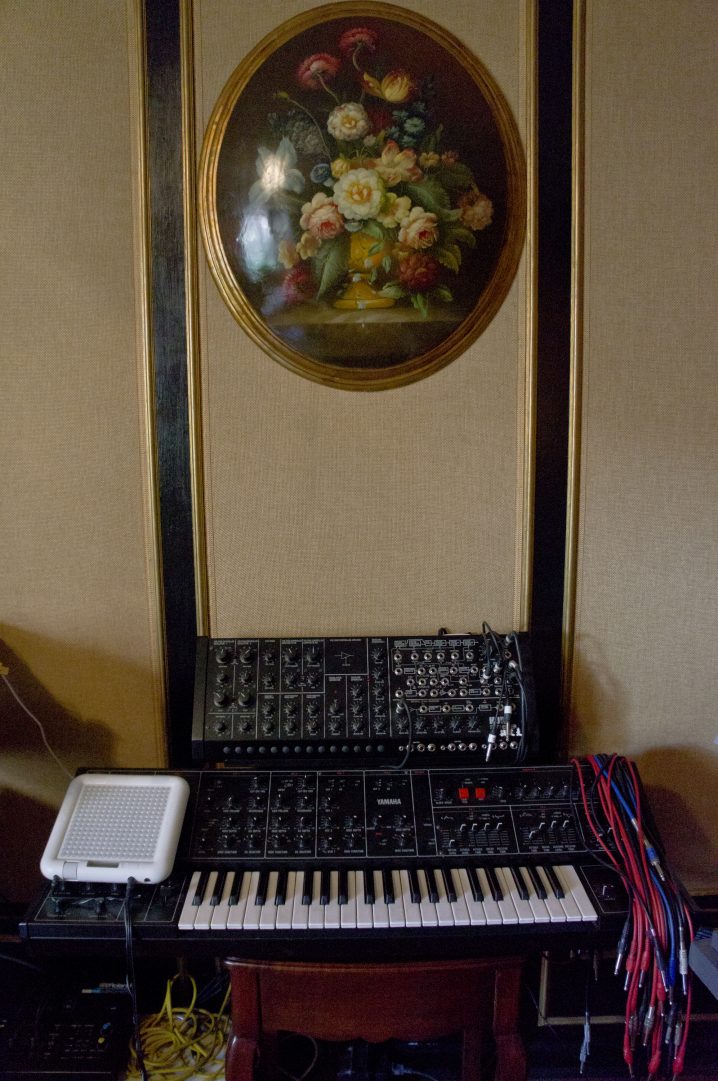
The main idea for the album had to do with a certain mood or feeling which I wanted to achieve, whose transmitting elements are sound design, vocals and lyrics, hence I spent most of my time defining those. I did many tests to figure out efficient workflow, making sure certain methods were reproducible, for example. I then started to work on almost all the songs at the same time, in a parallel manner, advancing bit by bit and also balancing the overall structure of the album that way. Many of the ideas that made it into the album then, I had been collecting in different notebooks, texts or audio files for a very long time. I remember that the main loop I used for “Simplicity” for example, I had found almost 20 years ago. It was sitting on my hard disc all these years. I knew that I wanted to use it for something specific, yet was waiting for the general framework where I could make it fit. At some point then I had written the lyrics and had decided that the song could work for “<3”.
This very much describes my process very well, I think. One can see it as hundreds of fragments floating around, sometimes for decades. Very often then, fragments from different periods start to attract each other and suddenly “make a song or track”. Every couple of months, I would go through my scrapbooks or the corresponding folders on the main hard disc and see if something sticks or not. I often throw stuff away then as well, when I think that I do no longer resonate with an idea. The chord progression I finally used on “0.9” for example, I had laid out as a very short MIDI file, maybe 15 years ago. It was sitting there in a Protools session, without any specific use in mind. Parallel to this, I had outlined a bass line and a beat for another track, which was sitting somewhere else. Both things were not intended for each other. I was then about to throw the chord progression off the hard drive because I couldn’t make it fit anywhere really, all those years.. .when it struck me that I could import it into the other demo… and it suddenly made perfect sense! It all came together in an instance and was not planned at all.
For situations like this to occur, I consider the order and organisation of my studio very important. I need to have a connection to what is on my hard discs and what is inside every machine (samples, etc.) and I permanently make them part of my creative thinking. In other cases, though I may very well just do something from scratch, in a very short period of time, if I feel that this is needed for a specific work. The long term work method though is the one I come back to more often. Getting to know your hard- and software, as you can see, are of utmost importance, since it determines the efficiency of how to turn those ideas into concrete proposals which then can be fleshed out.
After the piece is complete, how do you audition the results? What are your reactions to hearing your music in a different context, setting, or a sound system?
After a mix, I usually let the track sit for a while, maybe a week or so, without listening to it. I then go back to it, revising it in my studio, but also outside the studio, sometimes on crapy computer speakers, or a little Bose wireless soundbar. The later has surprisingly revealed many flaws of certain mixes to me. I then make mental notes of what could be wrong and go back to the mix and fix it. That process can sometimes be short and painless, or rather long and exhausting, which often depends on the complexity of the composition itself. In the case of “<3”, I mixed 80% of the album three times and the “mixdown” phase itself took two months.
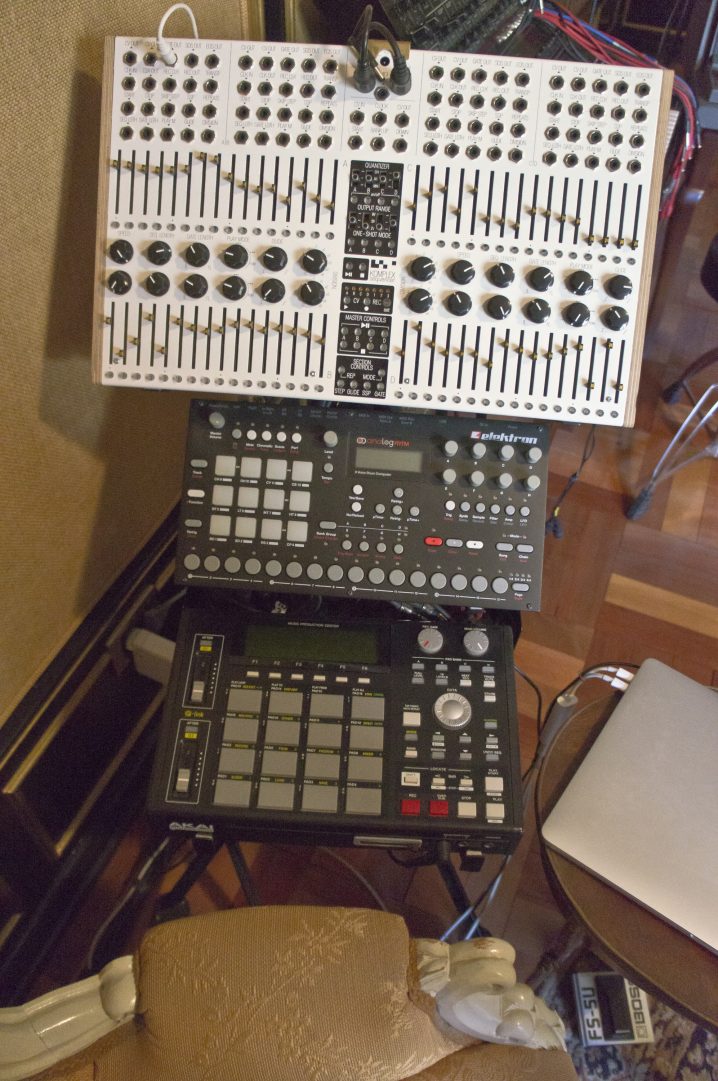
As for the reaction to listening to my music on different contexts/settings/sound systems, I am mainly interested in having the coarse idea of a song to come across, knowing that all the details are usually being lost. I am very aware that the details are mainly for my own pleasure and I am not disappointed they don’t come across outside my studio.
Do you ever procrastinate? If so, what do you usually find yourself doing during those times?
Unfortunately, anything I do is somehow connected to my music… even “doing nothing”… which is something that doesn’t come easy. So, “procrastinating”, in my opinion, doesn’t really exist for me. I could just try and watch an unspectacular movie when I would suddenly see or hear something that turns into a piece of the puzzle of composing a track. It’s hopeless!
What gets you inspired?
Anything, really!
And finally, what are your thoughts on the state of “electronic music” today?
Most importantly, I’m not following anything. I’m hardly online, I don’t consume media, I don’t listen to podcasts, and in general, I take my isolation (even outside the CV 19 lockdown) very seriously. The problem is, when your input is “media”, your “today” is somebody else’s past! That being said, the little contemporary music that reaches me and which, I guess, would be considered “electronic music”, I usually don’t find very exciting. As with everything, there is WAY too much of the same out there, and stuff that surprises me is rare. Not to get me wrong, this is not a complaint… I think I have gone beyond that. The current state of affairs, may it be in electronic music or other fields, is very similar everywhere. This has, of course, to do with the general cultural climate and its relationship to the economy and information technology. The point in history, where electronic music had no other template than one’s own imagination is certainly over. The very templates of the past have made the creation of new, unknown templates almost impossible. This is a structural issue of the genre which has transformed it into its current state. I am totally fine with this, though at the same time don’t really feel like I have anything to do with it.

Now, I have always pursued a more subjective path and shutting myself off from the obvious input has helped me a great deal to come up with ideas I have considered unique. My issue with musical input is, that one can not undo the information, once you have received it. No matter if you like or dislike something, it is THERE, as a positive or a negative, and clutters your CPU. Frankly, I don’t have time for that, and the signal to noise ratio is not good enough for me to spend time with it. One could go on on the stagnation of electronic music, then why’s and how’s, all topics I find really entertaining to analyse, though this may be for a different interview. Electronic music is dead. Long live electronic music.
Ⓐ™
